Introduction
The DJI RC Pro, engineered by SZ DJI TECHNOLOGY CO., LTD. (Model: RM510), sets a new standard in professional drone remote controls. Designed explicitly for seamless integration with leading DJI aircraft such as the Mavic 3, DJI Air 2S, and Mavic Air 2, the RC Pro delivers advanced video transmission, robust wireless connectivity, and a premium user experience in the field.
Certified under FCC ID SS3-RM51021, this device meets stringent US regulatory standards for RF emissions and electromagnetic compatibility. This certification not only ensures legal sale and operation in the United States but also reflects the device’s adherence to best practices in wireless performance and safety.
In this comprehensive analysis, we break down the DJI RC Pro’s standout features, wireless specifications, operating frequencies, and internal hardware. We also explore its regulatory compliance, use cases, and the engineering prowess behind its design—offering a detailed, expert-level resource for drone professionals, tech enthusiasts, and engineers alike.
Key Features & Specifications
The DJI RC Pro is purpose-built for demanding aerial imaging workflows, combining top-tier hardware with DJI’s latest wireless innovations. Below, we distill its most critical features and technical specifications, highlighting their real-world benefits and engineering significance.
Key Features
-
Live HD View Transmission Up to 12 km
Delivers ultra-low latency, high-definition video feed from supported DJI drones, empowering pilots with real-time situational awareness and precision control—even at extended distances. -
Support for Mavic 3, DJI Air 2S, and Mavic Air 2
Ensures seamless compatibility with DJI’s flagship UAV platforms, catering to both professional cinematographers and advanced hobbyists. -
OcuSync 3.0 (O3) Image Transmission Technology
Incorporates DJI’s latest proprietary wireless protocol, optimizing video clarity, anti-interference capability, and connection reliability. -
2×2 MIMO Wi-Fi
Employs multi-antenna (Multiple Input Multiple Output) technology for robust, high-throughput wireless communication, minimizing dropouts and maximizing transmission quality. -
Built-in 5.5-inch High Brightness 1000 cd/m² Touchscreen
Integrated display ensures visibility even under direct sunlight, with Full HD (1920×1080) resolution for sharp, vibrant imagery—eliminating the need for a separate mobile device. -
Speaker
Built-in audio output supports system notifications and playback, enhancing situational awareness. -
Mini HDMI Port
Facilitates direct video output for live broadcast, monitoring, or external recording—crucial for professional workflows. -
Expandable Storage via microSD Card
Adds flexibility for storing flight logs, video cache, and media, supporting extended missions and field operations.
Technical Specifications
- Transmission Power (EIRP):
- 2.400–2.4835 GHz: 32.0 dBm (FCC)
-
5.725–5.850 GHz: 33.5 dBm (FCC)
(Lower output for CE/SRRC/MIC regions, ensuring global regulatory compliance.) -
Operating Time: Up to 3 hours
-
Powered by a high-capacity 18650 Li-ion battery (5000 mAh @ 7.2 V), supporting extended field use.
-
Rated Power: 12 W
-
Efficient power consumption for all-day operation without excessive heat or bulk.
-
Wi-Fi:
- Standards: 802.11b/a/g/n/ac/ax
- Frequency Ranges: 2.400–2.4835 GHz, 5.725–5.850 GHz
-
Advanced multi-band Wi-Fi ensures compatibility with modern wireless infrastructure and proprietary drone links.
-
Bluetooth:
- Version: Bluetooth 5.1
- Transmission Power (EIRP): 6 dBm
-
Enables quick device pairing and peripheral connectivity.
-
Video Output Port: Mini HDMI
-
Professional-grade connectivity for real-time external monitoring.
-
Other Notables:
- Multiple FPC/FFC connectors for peripherals, supporting modular upgrades and serviceability.
- Extensive EMI/RFI shielding and robust thermal management, ensuring reliable operation in challenging RF environments.
These specifications collectively position the DJI RC Pro as a flagship-grade controller, purpose-built for mission-critical aerial operations, professional video capture, and demanding field conditions.
Operating Frequencies
The DJI RC Pro (FCC ID SS3-RM51021) operates across a sophisticated array of frequency bands and output power levels, as detailed in its FCC documentation. This multi-band, high-power wireless design underpins its long-range, low-latency performance.
| Frequency Range (GHz) | Output Power (mW) | FCC Rule Part |
|---|---|---|
| 2.402–2.48 | 2.8 | 15CCC3.12.4055 |
| 2.452 | 172.6 | 15CCC2.32.4225 |
| 2.4525 | 81.3 | 15CCC2.15.19 |
| 2.4615 | 427.6 | 15CCC2.62.4105 |
| 2.462 | 167.5 | 15CCC2.22.4132 |
| 2.4635 | 300.6 | 15CCC2.42.4105 |
| 2.4642 | 410.2 | 15CCC2.72.422 |
| 2.46512 | 299.9 | 15CCC2.52.412 |
| 2.4725 | 93.8 | 15CCC2.92.41112 |
| 2.4765 | 94 | 15CCC2.82.4095 |
| 5.23 | 191.9 | 15ECC4.25.21 |
| 5.795 | 135.2 | 15ECC1.25.755 |
| 5.795 | 135.2 | 15ECC4.55.775 |
| 5.825 | 125.9 | 15ECC4.45.7455 |
| 5.8295 | 91.8 | 15ECC1.15.7455 |
| 5.8295 | 91.8 | 15ECC4.135.755 |
| 5.8395 | 98.2 | 15ECC1.95.7355 |
| 5.8395 | 98.2 | 15ECC4.125.745 |
| 5.8445 | 445.7 | 15ECC4.95.7285 |
| 5.8445 | 88.5 | 15ECC1.85.7305 |
| 5.8445 | 88.5 | 15ECC4.115.7355 |
| 5.8465 | 388.2 | 15ECC1.45.7285 |
| 5.8465 | 388.2 | 15ECC4.75.73012 |
| 5.8472 | 440.6 | 15ECC1.75.7302 |
| 5.8472 | 440.6 | 15ECC4.15.7305 |
| 5.84812 | 421.7 | 15ECC1.55.73012 |
| 5.84812 | 421.7 | 15ECC4.85.7302 |
| 35.7275–5.8445 | 445.7 | 15ECC1.65.7275 |
| 35.775 | 127.9 | 15ECC4.6 |
These frequency allocations enable the RC Pro to leverage both 2.4 GHz and 5.8 GHz ISM bands, optimizing for range, throughput, and minimal interference across diverse environments. High output power, especially in the upper 5 GHz range, directly supports the controller’s extended operational distance and robust anti-interference capabilities.
Technology Deep Dive
The DJI RC Pro’s wireless architecture is anchored in advanced Wi-Fi (802.11b/a/g/n/ac/ax) and Bluetooth 5.1 technologies, with proprietary enhancements for drone control and video transmission. By operating in both 2.4 GHz and 5.8 GHz ISM bands, the controller achieves a balance between maximum range (2.4 GHz) and reduced interference/congestion (5.8 GHz), crucial for stable, real-time HD video feeds and responsive control.
The device’s 2×2 MIMO Wi-Fi implementation leverages multiple antennas to increase throughput and reliability, essential for maintaining a clear video link over long distances or in RF-dense environments. Bluetooth 5.1 further enhances connectivity for accessories and rapid device pairing, with sufficient power output to ensure stable short-range links.
The detailed frequency and power spectrum, as documented in FCC filings, reflects DJI’s commitment to regulatory compliance and optimal wireless performance. The high Effective Isotropic Radiated Power (EIRP) ratings ensure robust signal propagation, while extensive EMI/RFI shielding (as observed in internal photographs) minimizes self-interference and susceptibility to external RF noise.
Test reports confirm that the RC Pro meets or exceeds FCC requirements for spurious emissions, RF exposure, and electromagnetic compatibility, validating its suitability for professional and consumer use in demanding operational scenarios.
In-Depth Internal Component Analysis / Teardown
The internal architecture of the DJI RC Pro exemplifies cutting-edge embedded system design—balancing high performance, RF integrity, and modularity in a compact form factor. Below is a detailed analysis of key internal hardware, based on expert examination of component photographs.
The densely populated main PCB at the heart of the controller is immediately striking for its extensive use of metal EMI shields, covering what are almost certainly the main system-on-chip (SoC), memory modules, and RF transceivers. The size and placement of these shields, combined with visible thermal interface material, point to a high-integration, high-performance processor—likely ARM-based—capable of real-time video processing and multi-band wireless communication. The board’s dark soldermask, high via density, and large copper pours indicate a multilayer design optimized for signal integrity and robust grounding. Multiple FPC/FFC connectors support modular peripherals such as the display, buttons, and possibly camera modules, while test points and a crystal oscillator suggest thorough design for both reliability and serviceability. The visible power regulation components and speaker/buzzer highlight the device’s attention to power management and user feedback. Overall, this PCB reflects a premium-grade, highly engineered platform designed for reliability, thermal efficiency, and RF excellence—essential for mission-critical drone operation.
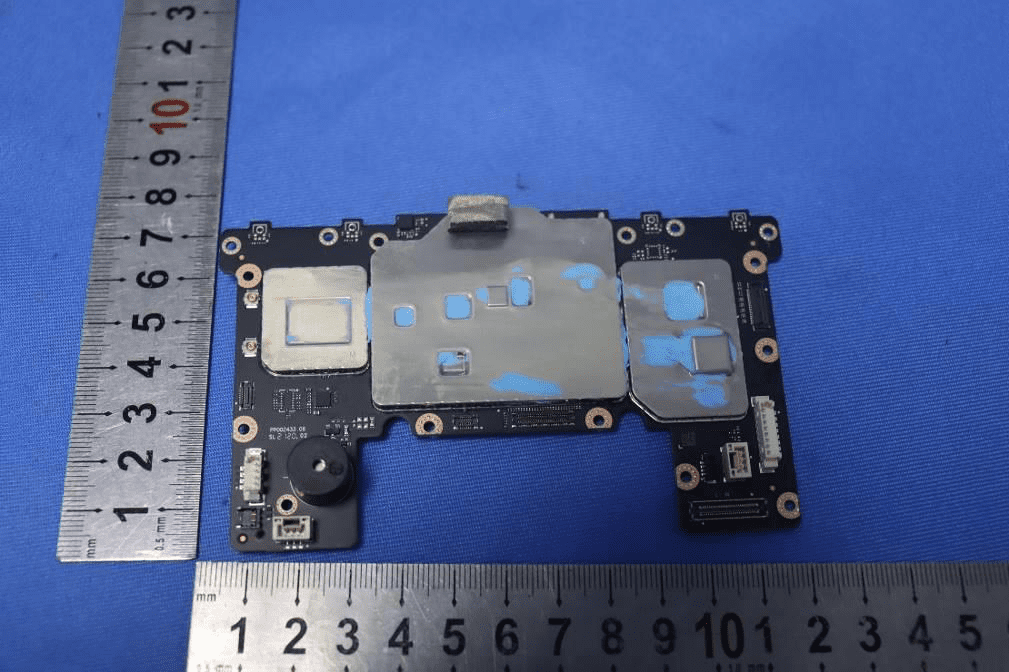
A broader internal view reveals the controller’s main PCB flanked by wiring, connectors, and large cylindrical battery cells—underscoring the RC Pro’s commitment to endurance and modularity. The prominent centrally-located IC, adjacent to an active cooling fan, is likely the primary SoC, handling intensive processing for video transmission and UI rendering. The presence of multiple antennas, connected via micro-coaxial cables, highlights the device’s multi-band RF capabilities. Numerous FPC/FFC connectors and modular design choices facilitate assembly, repair, and future upgrades. The use of active cooling and extensive shielding demonstrates the engineering rigor necessary to support high output power and processing loads, while maintaining compliance with stringent EMI standards. This subsystem integration ensures the RC Pro remains reliable and responsive even in prolonged or demanding operational scenarios.
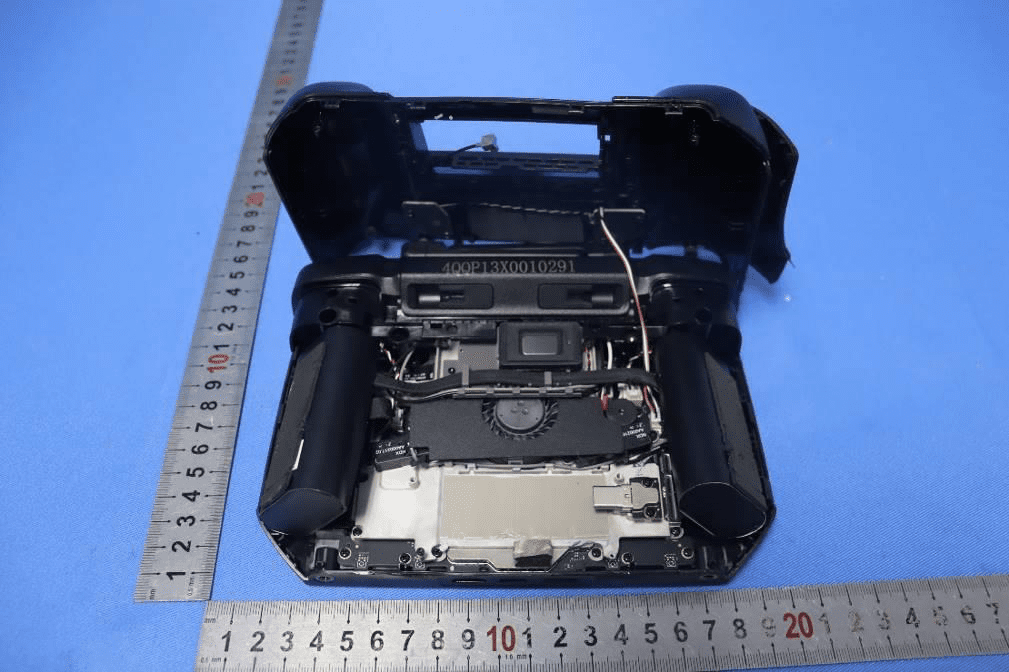
Another close-up of the main PCB further emphasizes the engineering focus on RF integrity and modularity. The compact, irregularly shaped board is optimized to fit within the device enclosure, with extensive use of metal shields over high-speed and RF circuitry. Large FPC connectors at the board edges suggest support for high-resolution display and other critical peripherals, while the dense via pattern and robust connector design reflect a high-speed, multi-layer layout. The careful grounding, shielding, and connector selection ensure minimal EMI leakage and reliable wireless performance, directly supporting the RC Pro’s hallmark features—long-range HD video transmission and responsive control. The overall build quality is consistent with professional-grade electronics, prioritizing both performance and reliability.
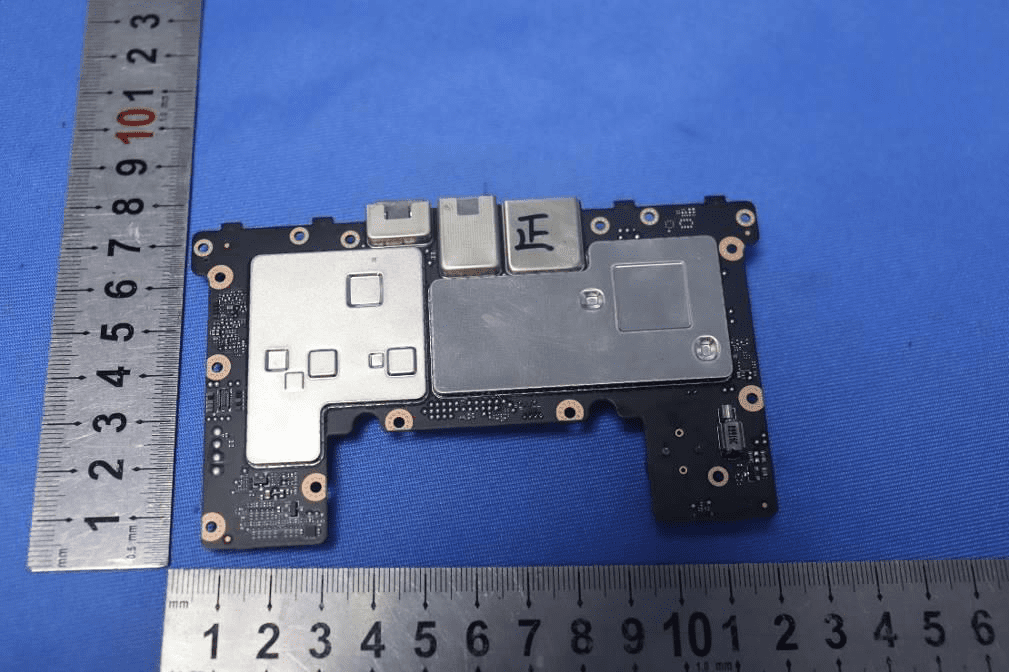
A detailed view of another PCB section reveals several major ICs under blue-tinted thermal pads, underscoring the emphasis on thermal management for high-power processing. The largest chip, likely the main SoC, is flanked by memory and power management ICs, while adjacent shielded regions house RF transceivers. The use of multiple large inductors and capacitors indicates robust local power regulation—vital for clean signal delivery and operational stability. The presence of differential pair routing and controlled impedance traces supports high-speed data transfer, a necessity for real-time video and low-latency control. The modular connector layout and numerous test points further highlight the device’s serviceability and engineering depth. This subsystem is integral to the RC Pro’s high-performance processing and multi-band wireless communication.
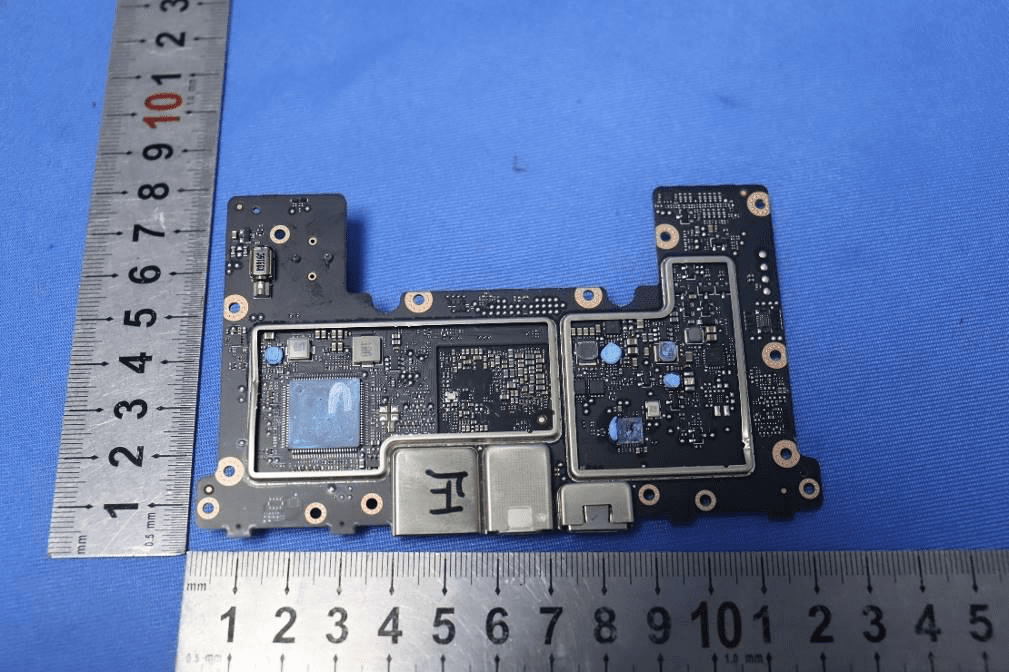
Examining another PCB assembly, the design’s sophistication becomes even more evident. Here, the central area is dominated by a shielded main processor, surrounded by memory and power components, all meticulously arranged to optimize signal flow and heat dissipation. Multiple FPC/FFC and multi-pin connectors provide flexible interfacing with peripherals and antennas, while the use of via-in-pad and microvias suggests a high-layer-count board—supporting complex high-speed and RF signal routing. The application of thermal interface material and the strategic use of shields ensure the device remains stable under load, with minimal EMI impact. The presence of a MEMS microphone or speaker and several crystals/oscillators rounds out a design built for both functionality and reliability, supporting the RC Pro’s diverse operational requirements.
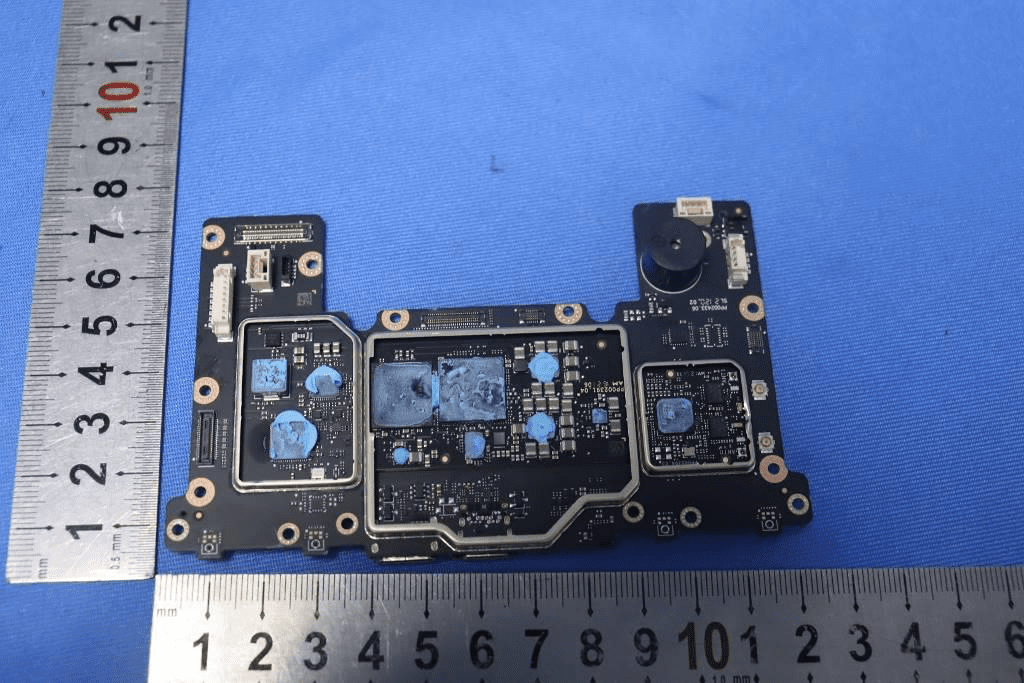
A focused view on a smaller PCB assembly highlights the device’s attention to detail in cooling, EMI management, and modularity. The visible IC, labeled ‘NDX PA0002176.02,’ is likely a specialized sensor or actuator, critical for system feedback or auxiliary functions. Prominent coaxial connectors support external antennas, while a dedicated cooling fan and substantial metallic shielding underscore the need for efficient heat dissipation and electromagnetic protection. The neat routing of wiring and careful connector placement reflect a design philosophy prioritizing ease of assembly and maintainability. This subsystem’s integration of thermal, RF, and power management components is essential for sustaining the RC Pro’s high-performance operation in real-world environments.
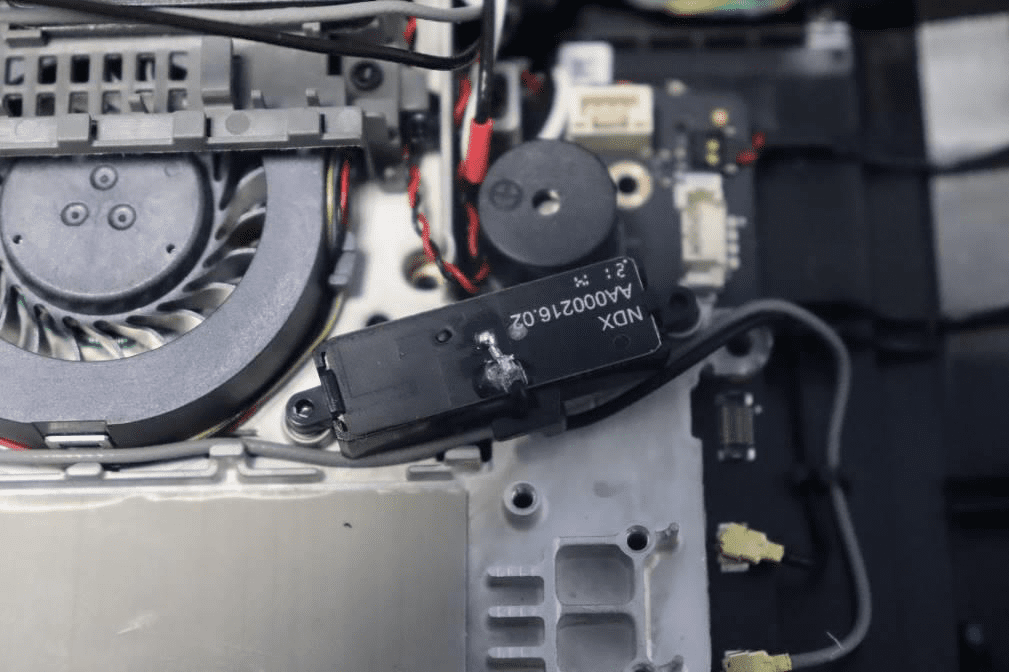
Regulatory Insights & FCC Filing
The DJI RC Pro (Model RM510), certified under FCC ID SS3-RM51021, demonstrates full compliance with US electromagnetic interference (EMI) and RF exposure standards. This certification—registered by FCC.gov—confirms that the device meets all necessary regulatory requirements for legal sale and operation within the United States.
FCC filings for the RC Pro encompass a range of critical documentation, including test reports for RF emissions and exposure, electromagnetic compatibility (EMC), internal and external photographs, product manuals, schematics, and block diagrams. These materials collectively verify that the controller’s powerful wireless subsystems operate safely within prescribed limits, ensuring minimal risk of interference with other electronic devices.
The user manual describes the RC Pro as a high-performance, smart controller featuring O3 (OcuSync 3.0) image transmission, a 5.5-inch high-brightness touchscreen, and robust wireless connectivity. Test reports detail the device’s adherence to power output, spurious emission, and frequency stability requirements—validating its operation across the specified 2.4 GHz and 5.8 GHz bands with high output power. Internal documentation highlights the use of advanced EMI/RFI shielding and thermal management, further supporting the device’s compliance and reliability.
This rigorous regulatory review process ensures that the DJI RC Pro not only delivers professional-grade performance but also upholds the safety and interoperability standards essential for widespread adoption in the US market.
Potential Use Cases & Target Audience
The DJI RC Pro is engineered for professional and advanced users who demand reliability, performance, and operational flexibility from their drone control systems. Its standout features and robust wireless architecture make it ideally suited for the following scenarios:
-
Professional Aerial Cinematography and Surveying
Filmmakers, photographers, and surveyors can leverage the RC Pro’s 12 km HD video transmission, high-brightness touchscreen, and HDMI output for real-time monitoring and precise framing—even in remote or challenging lighting conditions. The controller’s robust wireless link ensures minimal latency and uninterrupted video feeds, critical for capturing high-quality aerial content. -
Commercial UAV Operations and Inspections
Operators conducting infrastructure inspections, search and rescue, or agricultural surveys benefit from the RC Pro’s extended range, long battery life, and modular connectivity. The device’s compatibility with Mavic 3, Air 2S, and Mavic Air 2 platforms enables versatile deployment across a range of mission profiles. -
Advanced Enthusiasts and Field Technicians
Power users seeking a premium drone control experience will appreciate the RC Pro’s integrated, sunlight-readable display, rapid device pairing via Bluetooth 5.1, and support for expandable storage. Its rugged build and regulatory compliance ensure reliable performance in diverse environments.
By combining professional-grade features with user-friendly design, the DJI RC Pro serves a broad spectrum of aerial imaging and operational needs.
Conclusion
The DJI RC Pro by SZ DJI TECHNOLOGY CO., LTD. (Model RM510) stands out as a flagship remote controller, delivering industry-leading wireless performance, robust build quality, and premium user experience. Its FCC certification under ID SS3-RM51021 confirms both regulatory compliance and technical excellence, making it legal for sale and operation in the US. With cutting-edge features such as OcuSync 3.0, a high-brightness touchscreen, and sophisticated internal engineering, the RC Pro sets a new benchmark for professional drone controllers—empowering users to push the boundaries of aerial imaging and remote operations.